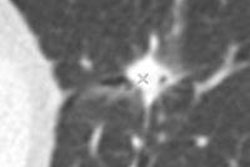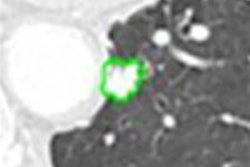Most of the recent research on the use of computer-aided detection (CAD) software for analyzing digital radiography (DR) studies of the chest has focused on lung cancer. But Italian researchers this month in European Journal of Radiology report good performance of an emphysema CAD algorithm that they developed at their institution.
Currently, CT is used as the gold standard for detecting emphysema, which is defined as a permanent enlargement of the airspaces distal to the terminal bronchiole. But CT is expensive and also delivers a higher radiation dose to patients than radiography, noted a research team led by Massimo Miniati, MD, of the University of Florence.
In a 2008 study, the authors presented a technique in which radiography was able to record sensitivity of 90% relative to CT for detecting chronic obstructive pulmonary disease (COPD) such as emphysema. In the current paper, they proposed to improve DR's performance even further by applying a CAD algorithm they developed that recognizes emphysema using simple descriptors of lung shape, they wrote. The study was published online ahead of print on September 11 in the European Journal of Radiology.
The algorithm works by evaluating structural emphysema brought about by chronic hyperinflation of the lungs, rather than airflow obstruction, according to the authors. The software extracts lung contours from posteroanterior (PA) and lateral chest radiographs. Chest radiologists reviewing images locate a number of "knot points" along the boundaries of the lungs in each radiograph, and the software draws automatic lung boundaries.
The software then identifies four points in the PA view corresponding to the apex and costophrenic angle of the right and left lung; the four points are the corners of a polygon, which the software then measures. Further image processing takes place, with the data fed to a neural network that is able to recognize emphysema based on descriptors of lung shape on radiography.
Testing the algorithm
The researchers decided to test the algorithm's accuracy in a population of 225 patients seen at the Institute of Clinical Physiology in Pisa between June 1, 2007, and July 31, 2008. The patients had already received CT scans, some (85%) for the presence of a solitary pulmonary nodule on chest radiography, and the rest as part of workup for suspected pulmonary arterial hypertension.
The patients were divided into a group of 118 individuals used as a derivation sample, with their chest radiographs used to develop the CAD algorithm for emphysema detection, and 107 patients as a validation sample, whose chest radiographs were used to test the software's diagnostic accuracy. Patients had a median age of 65 years; 96 were men.
Patients were judged to have COPD based on spirometry results; of the total number of study participants, 141 (63%) had the condition, broken down between 77 cases in the derivation sample and 64 in the validation sample.
To determine the accuracy of the CT gold standard, two blinded readers analyzed CT scans acquired on a 64-detector-row scanner (Aquilion 64, Toshiba Medical Systems, Tokyo) and rated the severity of emphysema. Chest radiographs were acquired on a commercially available DR unit (Thorax 2000, Imix, Tampere, Finland) and analyzed by the CAD software. The diagnostic performance of the CAD algorithm was assessed using receiver operator characteristics (ROC) curves, using the area under the curve as a numerical index.
Miniati and colleagues reported that the two readers analyzing the CT studies diagnosed emphysema consistently in 92 patients (41%), with disease prevalence slightly higher in the derivation group (43%) versus the validation group (38%).
The CAD algorithm posted an area under the ROC curve of 0.985 in analyzing images from patients in the derivation sample group, compared with 0.975 for those in the validation sample. This translated into a sensitivity of 92% in the derivation sample and 90% in the validation sample; specificity was 96% in the derivation sample and 97% in the validation sample.
The CAD software produced eight false-negative results, four in each of the patient groups, according to the authors. Five patients in the total sample size of 225 turned out to be false positive; two of these had COPD on spirometry but no emphysema on CT.
"The computer-aided procedure provided a nearly complete discrimination between patients with and those without emphysema on CT," Miniati and colleagues wrote.
The technique requires only about two minutes of interaction by the radiologist to extract lung contours from chest radiographs, the researchers noted, and it can help overcome factors that have confounded the appreciation of emphysema on lung radiographs. They suggested that the algorithm could be used for the online evaluation of emphysema at institutions that have converted to filmless operation. The authors indicated that they are developing a version of the software that can be downloaded over the Web, and that traces lung contours automatically.
Among the limitations of their study, Miniati and colleagues reported that the CAD technique requires that lung boundaries be clearly discernible on both PA and lateral chest radiographs. This means that disorders such as pleural effusion or extensive lung consolidation could hamper the ability to detect emphysema.
They also recommended that CT be used for assessing the extent and regional distribution of emphysema more precisely; the research also used semiquantitative methods of assessing emphysema on volumetric CT that rely on visual assessment, rather than more current quantitative approaches.
By Brian Casey
AuntMinnie.com staff writer
September 27, 2010
Related Reading
Chest x-ray CAD offers value in detecting lung cancers, June 18, 2010
Lung CAD performs best as second reader, May 7, 2010
Lung CAD boosts radiologist accuracy, February 17, 2010
CAD for chest x-ray detects overlooked subtle lung cancer, June 23, 2009
Computer-aided system increases detection of early-stage lung cancer, May 4, 2009
Copyright © 2010 AuntMinnie.com



















